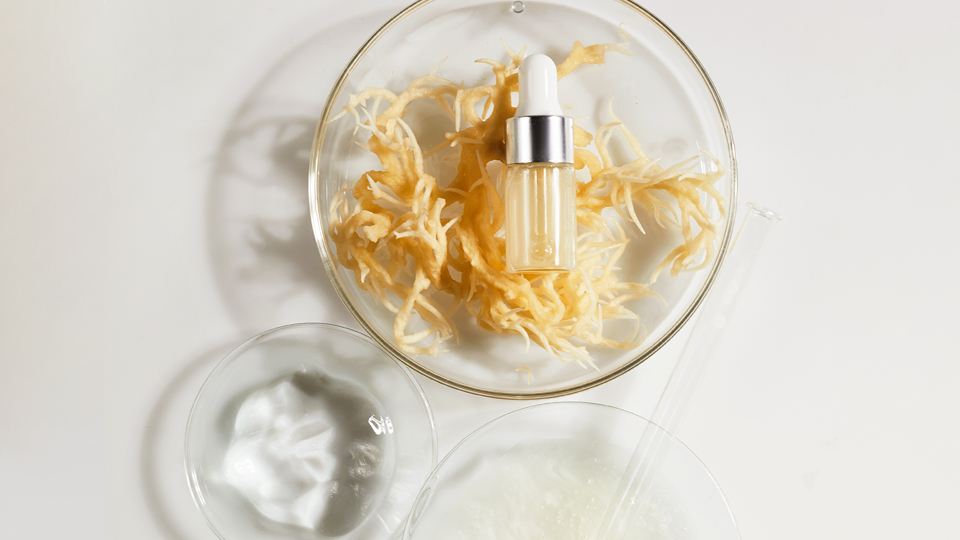With summer in the air, you may be interested in exploring sea moss as a remedy for eczema skin. It’s becoming a popular skincare product, but does it really work? Is it right for you and your eczema? We’ve consulted ecz-pert Dr. Jeff Yu, a board-certified dermatologist at Massachusetts General Hospital, and gathered the facts.
What is sea moss?
Sea moss is a type of red algae also known as Irish moss (or Chondrus crispus). Sea moss is gathered for its carrageenan, a natural ingredient often used to help thicken, emulsify, and preserve food and drinks. Carrageenan is available in several forms, including gels, pills, powders, and gummies.
How can it help eczema, and why?
Sea moss may be a helpful alternative to corticosteroids or cortisone cream for treating eczema because of its unique anti-inflammatory, antifungal, and antiviral properties. Sea moss contains polyphenols, which are linked to decreasing inflammation.1 Inflammation is a key contributing factor in eczema, which is why sea moss may be an effective remedy for managing eczema flares.
Additionally, sea moss contains several vitamins (A, B, C, D, E, and K) and minerals (iodine, potassium, iron, zinc, calcium, magnesium, and more), which are known to contribute to healthy skin.2
What form of it is safest for eczema skin?
While creams and serums are often used to apply to skin, few credible sources outline what form is best or safest for eczema skin.
Are there any potential drawbacks?
Dr. Yu also believes that you should be wary of natural treatments. “Just because something is ‘natural’ or exists in nature doesn’t mean it’s safe for your skin,” Dr. Yu said. “I’m sure you’ve heard of the adage before that ‘poison ivy is also natural.’”

Additionally, you may be allergic to sea moss if you are allergic to sulfur or shellfish.
Dr. Yu cautioned against adopting sea moss to treat eczema due to the lack of research and evidence to support how it may be beneficial for people with eczema.
Dr. Yu warned, “Without any studies to support the efficacy and safety of using sea moss for eczema treatment, I’d avoid it as a general rule of thumb. When my patients approach me about a new treatment I don’t know much about or have heard about,
I usually look into the literature to see if there are studies published on it. There isn’t much on PubMed, which is where almost all medical literature is published. Therefore, I would not recommend it to patients.”
Dr. Yu also believes that you should be wary of natural treatments. “Just because something is ‘natural’ or exists in nature doesn’t mean it’s safe for your skin,” Dr. Yu said. “I’m sure you’ve heard of the adage before that ‘poison ivy is also natural.’”
Additionally, exposure to iodine may also be a risk for hypothyroidism, and you may have an allergic reaction to sea moss if you are allergic to sulfur or shellfish.
Where can I find it and how expensive is it?
Dr. Yu expressed concern about the cost of sea moss and its efficacy. “It’s probably expensive, but it’s probably not more effective than your cheap over-the-counter moisturizers like Vaseline ointment,” he said. “And worst case scenario, it can make your eczema worse because you could have an allergic reaction to it. I’d avoid it.”
It will likely be available at your local health foods store if you’re still interested in trying out sea moss. There are also several different vendors who sell sea moss online. Depending on the product, prices range from around $30 to over $100.
Key takeaway
In sum, ask your doctor before jumping into a new remedy, and know that while there are some anecdotal benefits attributed to sea moss, there is little research currently available to support them.
Learn more about alternative treatments for eczema here.
References:
- Hussain, Tarique et al. “Oxidative Stress and Inflammation: What Polyphenols Can Do for Us?.” Oxidative Medicine and Cellular Longevity, vol. 2016 (2016): 7432797. doi:10.1155/2016/7432797
- Shapiro, S S, and C Saliou. “Role of vitamins in skin care.” Nutrition (Burbank, Los Angeles County, Calif.) vol. 17,10 (2001): 839-44. doi:10.1016/s0899-9007(01)00660-8
